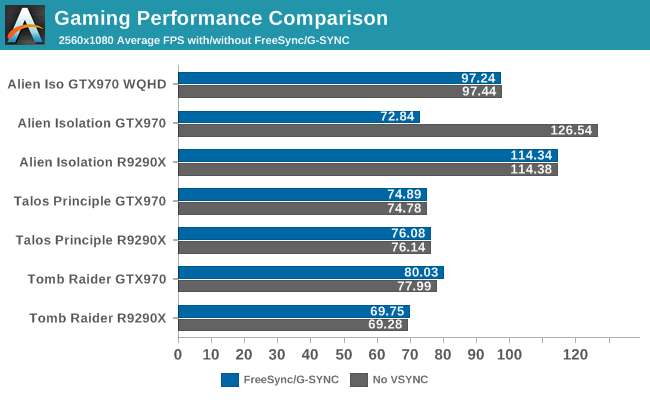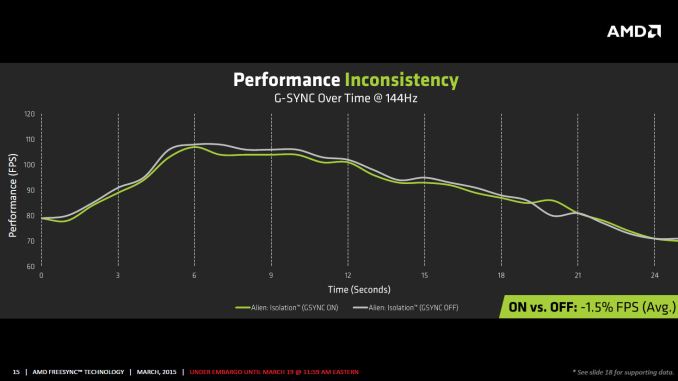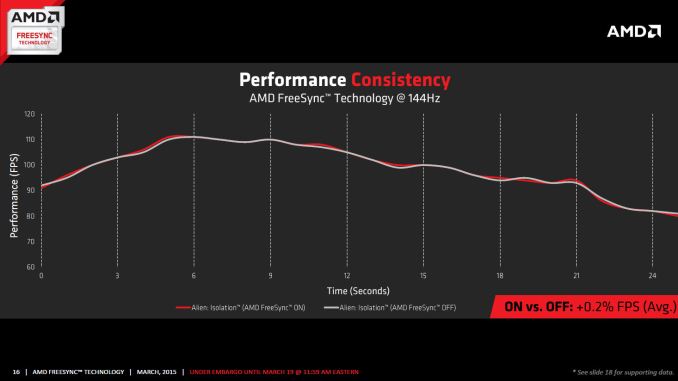The AMD FreeSync Review
by Jarred Walton on March 19, 2015 12:00 PM ESTFreeSync vs. G-SYNC Performance
One item that piqued our interest during AMD’s presentation was a claim that there’s a performance hit with G-SYNC but none with FreeSync. NVIDIA has said as much in the past, though they also noted at the time that they were "working on eliminating the polling entirely" so things may have changed, but even so the difference was generally quite small – less than 3%, or basically not something you would notice without capturing frame rates. AMD did some testing however and presented the following two slides:
It’s probably safe to say that AMD is splitting hairs when they show a 1.5% performance drop in one specific scenario compared to a 0.2% performance gain, but we wanted to see if we could corroborate their findings. Having tested plenty of games, we already know that most games – even those with built-in benchmarks that tend to be very consistent – will have minor differences between benchmark runs. So we picked three games with deterministic benchmarks and ran with and without G-SYNC/FreeSync three times. The games we selected are Alien Isolation, The Talos Principle, and Tomb Raider. Here are the average and minimum frame rates from three runs:


Except for a glitch with testing Alien Isolation using a custom resolution, our results basically don’t show much of a difference between enabling/disabling G-SYNC/FreeSync – and that’s what we want to see. While NVIDIA showed a performance drop with Alien Isolation using G-SYNC, we weren’t able to reproduce that in our testing; in fact, we even showed a measurable 2.5% performance increase with G-SYNC and Tomb Raider. But again let’s be clear: 2.5% is not something you’ll notice in practice. FreeSync meanwhile shows results that are well within the margin of error.
What about that custom resolution problem on G-SYNC? We used the ASUS ROG Swift with the GTX 970, and we thought it might be useful to run the same resolution as the LG 34UM67 (2560x1080). Unfortunately, that didn’t work so well with Alien Isolation – the frame rates plummeted with G-SYNC enabled for some reason. Tomb Raider had a similar issue at first, but when we created additional custom resolutions with multiple refresh rates (60/85/100/120/144 Hz) the problem went away; we couldn't ever get Alien Isolation to run well with G-SYNC using our custome resolution, however. We’ve notified NVIDIA of the glitch, but note that when we tested Alien Isolation at the native WQHD setting the performance was virtually identical so this only seems to affect performance with custom resolutions and it is also game specific.
For those interested in a more detailed graph of the frame rates of the three runs (six total per game and setting, three with and three without G-SYNC/FreeSync), we’ve created a gallery of the frame rates over time. There’s so much overlap that mostly the top line is visible, but that just proves the point: there’s little difference other than the usual minor variations between benchmark runs. And in one of the games, Tomb Raider, even using the same settings shows a fair amount of variation between runs, though the average FPS is pretty consistent.


















350 Comments
View All Comments
medi03 - Thursday, March 19, 2015 - link
nVidia's roalty cost for GSync is infinity.They've stated they were not going to license it to anyone.
chizow - Thursday, March 19, 2015 - link
It's actually nil, they have never once said there is a royalty fee attached to G-Sync.Creig - Friday, March 20, 2015 - link
TechPowerup"NVIDIA Sacrifices VESA Adaptive Sync Tech to Rake in G-SYNC Royalties"
WCCF Tech
"AMD FreeSync, unlike Nvidia G-Sync is completely and utterly royalty free"
The Tech Report
"Like the rest of the standard—and unlike G-Sync—this "Adaptive-Sync" feature is royalty-free."
chizow - Friday, March 20, 2015 - link
@CreigAgain, please link confirmation from Nvidia that G-Sync carries a penny of royalty fees. BoM for the G-Sync module is not the same as a Royalty Fee, especially because as we have seen, that G-Sync module may very well be the secret sauce FreeSync is missing in providing an equivalent experience as G-Sync.
Indeed, a quote from someone who didn't just take AMD's word for it: http://www.pcper.com/reviews/Displays/AMD-FreeSync...
"I have it from people that I definitely trust that NVIDIA is not charging a licensing fee to monitor vendors that integrate G-Sync technology into monitors. What they do charge is a price for the G-Sync module, a piece of hardware that replaces the scalar that would normally be present in a modern PC display. "
JarredWalton - Friday, March 20, 2015 - link
Finish the quote:"It might be a matter of semantics to some, but a licensing fee is not being charged, as instead the vendor is paying a fee in the range of $40-60 for the module that handles the G-Sync logic."
Of course, royalties for using the G-SYNC brand is the real question -- not royalties for using the G-SYNC module. But even if NVIDIA doesn't charge "royalties" in the normal sense, they're charging a premium for a G-SYNC scaler compared to a regular scaler. Interestingly, if the G-SYNC module is only $40-$60, that means the LCD manufacturers are adding $100 over the cost of the module.
chizow - Friday, March 20, 2015 - link
Why is there a need to finish the quote? If you get a spoiler and turbo charger in your next car, are they charging you a royalty fee? It's not semantics to anyone who actually understands the simple notion: better tech = more hardware = higher price tag.AnnihilatorX - Sunday, March 22, 2015 - link
Nvidia is making profit over the Gsync module, how's that different from a royalty?chizow - Monday, March 23, 2015 - link
@AnnihilatorX, how is "making profit from" suddenly the key determining factor for being a royalty? Is AMD charging you a royalty every time you buy one of their graphics cards? Complete and utter rubbish. Honestly, as much as some want to say it is "semantics", it really isn't, it comes down to clear definitions that are specific in usage particularly in legal or contract contexts.A Royalty is a negotiated fee for using a brand, good, or service that is paid continuously per use or at predetermined intervals. That is completely different than charging a set price for Bill of Material for an actual component that is integrated into a product you can purchase at a premium. It is obvious to anyone that additional component adds value to the product and is reflected in the higher price. This is in no way, a royalty.
Alexvrb - Monday, March 23, 2015 - link
Jarred, Chizow is the most diehard Nvidia fanboy on Anandtech. There is nothing you could say to him to convince him that Freesync/Adaptive Sync is in any way better than G-Sync (pricing or otherwise). Just being unavailable on Nvidia hardware makes it completely useless to him. At least until Nvidia adopts it. Then it'll suddenly be a triumph of open standards, all thanks to VESA and Nvidia and possibly some other unimportant company.chizow - Monday, March 23, 2015 - link
And Alexvrb is one of the staunchest AMD supporters on Anandtech. There is quite a lot that could convince me FreeSync is better than G-Sync, that it actually does what it sets out to do without issues or compromise, but clearly that isn't covered in this Bubble Gum Review of the technology. Unlike the budget-focused crowd that AMD targets, Price is not going to be the driving factor for me especially if one solution is better than the other at achieving what it sets out to do, so yes, while Freesync is cheaper, to me it is obvious why, it's just not as good as G-Sync.But yes, I'm honestly ambivalent to whether or not Nvidia supports Adaptive Sync or not, as long as they continue to support G-Sync as their premium option than it's np. Supporting Adaptive Sync as their cheap/low-end solution would just be one less reason for anyone to buy an AMD graphics card, which would probably be an unintended consequence for AMD.